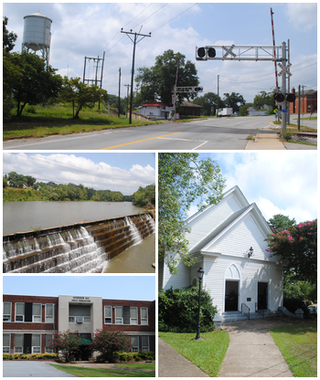
Pelzer is a town in Anderson County in South Carolina, United States, along the Saluda River. The population was 89 at the 2010 census, and grew to 1,344 at the 2020 census.

Ware Shoals is a town in Abbeville, Greenwood, and Laurens counties in the U.S. state of South Carolina, along the Saluda River. Ware Shoals has a population of 1,607 according to the 2020 United States Census.

Piedmont is a census-designated place (CDP) along the Saluda River in Anderson and Greenville counties in the U.S. state of South Carolina. The population was 5,411 at the 2020 census.
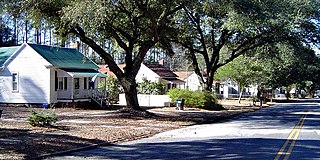
Vaucluse is an unincorporated community in Aiken County in the U.S. state of South Carolina. Vaucluse is part of the Augusta, Georgia metropolitan area.

The Saluda River is a principal tributary of the Congaree River, about 200 mi (320 km) long, in northern and western South Carolina in the United States. Via the Congaree River, it is part of the watershed of the Santee River, which flows to the Atlantic Ocean.

Dallas Mill was a manufacturer of cotton sheeting in Huntsville, Alabama, United States. The first of four major textile mills in Huntsville, the mill operated from 1891 until 1949, before it was converted for use as a warehouse in 1955 and burned in 1991. The village, constructed to house workers and their families, was incorporated into the city in 1955. The mill and its mill village are listed on the National Register of Historic Places.
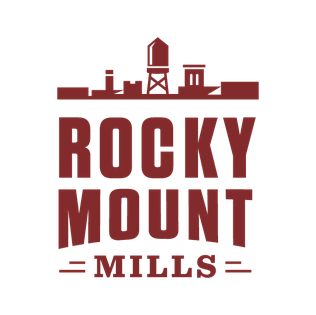
Rocky Mount Mills, located in Rocky Mount, North Carolina, was the second cotton mill constructed in the state of North Carolina, dating back to 1816. Capitol Broadcasting Company bought the 150-acre (61 ha) mills in the 2007 and has since redeveloped it into a mixed-use campus of breweries, restaurants, lofts, office, and event space.

This is a list of the National Register of Historic Places listings in Greenville County, South Carolina outside the city of Greenville.
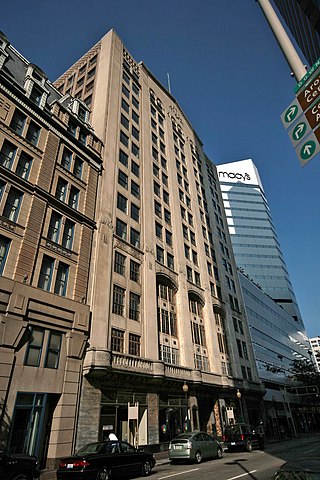
Lockwood, Greene & Company was an American engineering firm. It was active under various names from 1871 to 2017.

The Vaucluse Historic District, located in Vaucluse, South Carolina in Aiken County. The district includes the mill, number of accompanying buildings, and over eighty mill village homes. The district is noteworthy in that it is considered to be oldest mill village in the state. No less significant, the mill building, completed in 1877, was based on the plans of engineers A. D. Lockwood & Company of Providence, Rhode Island. The Lockwood successor firm, Lockwood, Greene & Company, would later design around fifty of South Carolina's textile manufacturing facilities. The Vancluse Historic District was listed in the National Register of Historic Places on May 7, 1996.

Mills Mill was a textile mill in Greenville, South Carolina (1897-1978) that in the 21st century was converted into loft-style condominia. The building is listed on the National Register of Historic Places.

Monaghan Mill, now the Lofts of Greenville, is a former textile mill (1900–2001) in Greenville, South Carolina, that in the early 21st century was converted into loft apartments. The building is listed on the National Register of Historic Places.

Woodside Cotton Mill Village Historic District is a national historic district located in Greenville County, South Carolina. The district encompasses 278 contributing buildings and 2 contributing sites in an early 20th century urban South Carolina textile mill village. Centered on a mill founded by John T. Woodside in 1902, the district is located just west of the city limits of Greenville and is largely intact despite modernizations made by a succession of mill and home owners. The mill itself is a rectangular, brick, four-story building designed by J.E. Sirrine and built between 1902 and 1912. Eventually the mill became the largest cotton mill under one roof in the United States and one of the largest in the world.

The Merrimack Mill Village Historic District is a historic district in Huntsville, Alabama. The cotton mill was built in 1900 by the Merrimack Manufacturing Company, reaching a peak of 1,600 employees by 1955. The mill was sold in 1946, and became known as the Huntsville Manufacturing Company. It operated until 1989 and was torn down in 1992. Houses in the adjoining mill village were built between 1900 and 1937, and encompass many mill house styles not commonly seen outside New England. The district was listed on the National Register of Historic Places in 2010.

Easley Mill is a historic mill complex in Easley, South Carolina. The mill was the first of three built in Easley between 1899 and 1910. The main building was completed in 1900, and is a four-story brick structure designed by preeminent mill architects Lockwood, Greene & Co. It was built during a boom in the textile industry across the Southern United States; more than 70 mills were opened in South Carolina alone between 1895 and 1903. The mill met with immediate success, including large shipments for export to China. By 1907, the mill contained over 37,000 spindles and 1,000 looms, and employed 500. It was sold to Woodside Mills of Greenville in 1920, and to Dan River, Inc. in 1956, who operated the mill until 1990. The mill has a shallow-pitched hip roof with bracketed eaves. Most of the arched window openings have been bricked over. Other structures on the site include a one-story office building, a warehouse, smokestack, an ice house, water tower, and monument to the mill's founder, John Mattison Geer. The mill was listed on the National Register of Historic Places in 2013. A proposal was made to convert the building to apartments in 2019.

Brandon Mill, now the West Village Lofts, is a historic textile mill complex, situated just west of the city of Greenville, Greenville County, South Carolina. The mill was built during the early decades of the 20th century and is one example of the mills in the Greenville "Textile Crescent" that became central to the economic development of the South Carolina upstate during this period. The complex was listed on the National Register of Historic Places in 2014, and the main mill has been converted into loft apartments.

The American Spinning Company Mill No. 2 is a historic mill complex at 300 Hammett Street, in a pocket of unincorporated Greenville County, South Carolina surrounded on three sides by the city of Greenville. It is a five-story brick building, to which a number of warehouse buildings and other additions were made. It was built in 1901-02, as part of a major expansion to the American Spinning Company's Mill No. 1, which originally stood just south of Hammett Street. It was built by Oscar Sampson, a Boston textile manufacturer to a design by the industrial design firm Lockwood and Greene, and is one of thirteen early 20th-century mills surviving in the Greenville area. It was listed on the National Register of Historic Places in 2016. Its major tenant now is the Victor Mill Company, a furniture maker.
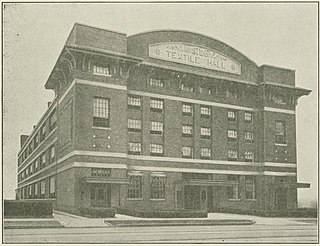
Old Textile Hall was a former building in Greenville, South Carolina, which from 1917 to 1962, hosted the Southern Textile Exposition, a trade fair for textile machinery. The building also functioned as a municipal auditorium for Greenville until 1958. Old Textile Hall was listed on the National Register of Historic Places in 1980, but it was removed after the building was demolished in 1992.

Amos DeForest Lockwood (1811–1884) was an American manufacturer and engineer based in Providence, Rhode Island. He was self-trained as a mechanical engineer, and gradually expanded his scope to all areas of textile mill construction. He was a cofounder, in 1882, of Lockwood, Greene & Company, which would become one of the largest engineering firms in the United States in the twentieth century.
























